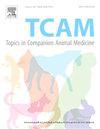摩洛哥犬科和猫科肿瘤评估:对 250 例病例的前瞻性观察研究结果(2020-2023 年)。
IF 1.3
3区 农林科学
Q2 VETERINARY SCIENCES
引用次数: 0
摘要
这项研究旨在评估摩洛哥犬科和猫科肿瘤的组织学类型和患者特征。在一项前瞻性观察研究中,从摩洛哥的兽医诊所收集了 250 份肿瘤样本。对每个病例的品种、年龄、性别、绝育情况、肿瘤部位和组织类型进行了分析。在 250 例肿瘤中,201 例(80.4%)来自狗,49 例(19.6%)来自猫。狗最常见的肿瘤部位是生殖道(36.8%),其次是皮肤和软组织(27.4%)和乳腺(14.9%)。在猫中,大多数肿瘤来自皮肤和软组织(55.1%),其次是乳腺(20.4%)和口腔(14.3%)。最常见的犬组织学肿瘤类型是传染性性病肿瘤(CTVT1)(31.8%)和乳腺癌(14.4%)。猫科动物最常见的肿瘤是鳞状细胞癌(34.7%)和乳腺癌(20.4%)。狗和猫确诊时的中位年龄分别为 7 岁和 10 岁。狗的性别分布均匀;猫的性别分布则以雌性居多。大多数猫和大约一半的狗是混血儿。与其他国家的人群相比,所评估的犬科和猫科肿瘤在肿瘤类型和患者特征方面存在差异,部分原因是CTVT和可能由太阳诱发的猫科皮肤肿瘤数量较多。本文章由计算机程序翻译,如有差异,请以英文原文为准。
Evaluation of canine and feline tumors in Morocco: Results of a prospective observational study of 250 cases (2020-2023).
This work aimed to evaluate the histologic tumor types and patient characteristics of canine and feline neoplasias in Morocco. In a prospective, observational study, 250 tumor samples were collected from veterinary clinics in Morocco. For each case, breed, age, sex, neuter status, and tumor site and histotype were analyzed. Among the 250 tumors, 201 (80.4%) were from dogs and 49 (19.6%) from cats. Most common tumor location in dogs was the reproductive tract (36.8%), followed by skin and soft tissues (27.4%) and mammary gland (14.9%). In cats, most tumors originated from the skin and soft tissues (55.1%), followed by mammary gland (20.4%) and oral cavity (14.3%). Commonest canine histologic tumor types were transmissible venereal tumor (CTVT1) (31.8%) and mammary carcinoma (14.4%). Squamous cell carcinoma (34.7%) and mammary carcinoma (20.4%) represented the most frequent feline neoplasms. Median age of dogs and cats at diagnosis was 7 and 10 years, respectively. Gender distribution was even in dogs; in cats, females were overrepresented. Most cats and about half of dogs were mixed-breed. The evaluated canine and feline neoplasias show differences in their tumor types and patient characteristics when compared to populations from other countries, in part based on the high number of CTVT and - possibly solar-induced –feline skin tumors.
求助全文
通过发布文献求助,成功后即可免费获取论文全文。
去求助
来源期刊

Topics in companion animal medicine
农林科学-兽医学
CiteScore
2.30
自引率
0.00%
发文量
60
审稿时长
88 days
期刊介绍:
Published quarterly, Topics in Companion Animal Medicine is a peer-reviewed veterinary scientific journal dedicated to providing practitioners with the most recent advances in companion animal medicine. The journal publishes high quality original clinical research focusing on important topics in companion animal medicine.
 求助内容:
求助内容: 应助结果提醒方式:
应助结果提醒方式:


